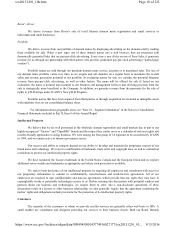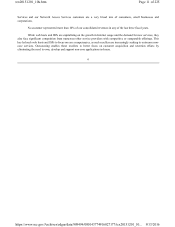Tucows 2015 Annual Report Download - page 19
Download and view the complete annual report
Please find page 19 of the 2015 Tucows annual report below. You can navigate through the pages in the report by either clicking on the pages listed below, or by using the keyword search tool below to find specific information within the annual report.
Ting may face competitive pressure to reduce prices for our products and services, which may adversely affect our
profitability and other financial results.
As competition in the U.S. wireless communications industry has increased, providers have lowered prices or
increased the number of minutes, messages and/or data units available under monthly service plans to attract or retain
customers. To remain competitive with existing and future competitors, we may be compelled to offer greater subsidies for
our handsets, reduce the prices for our services or increase the minutes, messages and/or data units that we offer under our
postpaid monthly plans. Any subsidies or price reductions that we offer in order to remain competitive may reduce our
margins and revenues, and may adversely affect our profitability and cash flows. Lower handset prices may also make our
services more accessible to new, lower-value customers with less disposable income available to spend on our services. In
addition, as handset prices decline and handsets become more disposable, customers without long-term contracts may
change their wireless providers more frequently, thereby increasing our churn and resulting in higher acquisition costs to
replace those customers. A shift to lower value or less loyal customers could have an adverse impact on our results of
operations and cash flows.
The blurring of the traditional dividing lines among long distance, local, wireless, video and Internet services
contributes to increased competition for Ting services.
The traditional dividing lines among long distance, local, wireless, video and Internet services are increasingly
becoming blurred. In addition, the dividing lines between voice and data services are also becoming blurred. Through
mergers, joint ventures and various service expansion strategies, major providers are striving to provide integrated services
in many of the markets we serve. This trend is also reflected in changes in the regulatory environment that have
encouraged competition and the offering of integrated services. We expect competition to continue to intensify as a result
of the entrance of new competitors or the expansion of services offered by existing competitors. If we cannot compete
effectively, our revenues, growth and profitability may be materially adversely affected.
If Ting is unable to keep pace with technological advances, our revenues, growth and profitability may be materially
adversely affected.
The U.S. wireless communications industry is experiencing rapid growth of new technologies, products and
services. We cannot predict which of many possible future technologies, products, or services will be important to
maintain our competitive position or what expenditures we will be required to make in order to develop and provide these
technologies, products or services. To the extent we do not keep pace with technological advances or fail to timely respond
to changes in the competitive environment affecting our industry, we could lose market share or experience a decline in
revenue, cash flows and net income. As a result of the financial strength and benefits of scale enjoyed by some of our
competitors, they may be able to offer services at lower prices than we can, thereby adversely affecting our revenues,
growth and profitability.
Ting employs a postpaid business model which exposes us to increased credit risk.
Ting offers its wireless services on a postpaid basis. The success of its postpaid offerings depends on its ability to
manage its credit risk while attracting new customers with profitable usage patterns. Ting has a short operating history and
there can be no assurance that it will be able to manage its credit risk or generate sufficient revenue to cover its postpaid-
related expenses, including losses arising from its customers’ failure to make payments when due. Ting manages credit risk
exposure using techniques that are designed to set terms and limits for the credit risk it accepts. The techniques it uses may
not accurately predict future defaults due to, among other things, inaccurate assumptions or fraud. Ting’s ability to manage
credit risk may also be adversely affected by legal or regulatory changes, competitors’ actions, consumer behavior, and
inadequate collections staffing or techniques. While Ting continually seeks to improve its assumptions and controls, its
failure to manage its credit risks appropriately may materially adversely affect our profitability and ability to grow.
Ting may be limited in its ability to grow its business and customer base for its wireless service offerings unless it can
continue to obtain network capacity at favorable rates and meet the growing demands on its business systems and
processes.
Page 1
9
of 22
5
tcx20151201_10k.ht
m
9
/
13
/
201
6
https://www.sec.gov/Archives/edgar/data/909494/000143774916027177/tcx20151201_10...
























